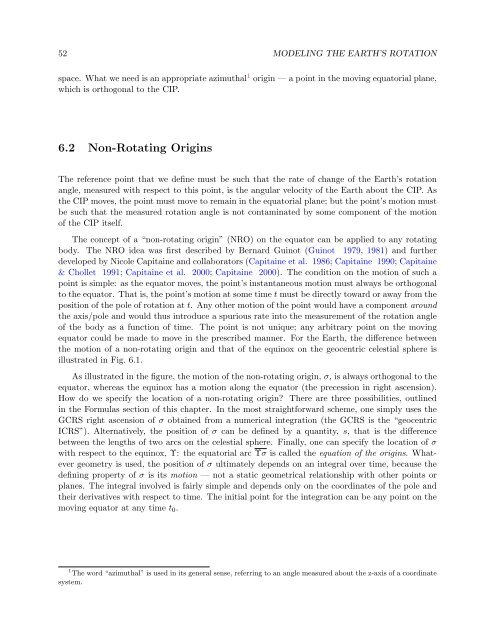USNO Circular 179 - U.S. Naval Observatory
USNO Circular 179 - U.S. Naval Observatory
USNO Circular 179 - U.S. Naval Observatory
Create successful ePaper yourself
Turn your PDF publications into a flip-book with our unique Google optimized e-Paper software.
52 MODELING THE EARTH’S ROTATION<br />
space. What we need is an appropriate azimuthal 1 origin — a point in the moving equatorial plane,<br />
which is orthogonal to the CIP.<br />
6.2 Non-Rotating Origins<br />
The reference point that we define must be such that the rate of change of the Earth’s rotation<br />
angle, measured with respect to this point, is the angular velocity of the Earth about the CIP. As<br />
the CIP moves, the point must move to remain in the equatorial plane; but the point’s motion must<br />
be such that the measured rotation angle is not contaminated by some component of the motion<br />
of the CIP itself.<br />
The concept of a “non-rotating origin” (NRO) on the equator can be applied to any rotating<br />
body. The NRO idea was first described by Bernard Guinot (Guinot 1979, 1981) and further<br />
developed by Nicole Capitaine and collaborators (Capitaine et al. 1986; Capitaine 1990; Capitaine<br />
& Chollet 1991; Capitaine et al. 2000; Capitaine 2000). The condition on the motion of such a<br />
point is simple: as the equator moves, the point’s instantaneous motion must always be orthogonal<br />
to the equator. That is, the point’s motion at some time t must be directly toward or away from the<br />
position of the pole of rotation at t. Any other motion of the point would have a component around<br />
the axis/pole and would thus introduce a spurious rate into the measurement of the rotation angle<br />
of the body as a function of time. The point is not unique; any arbitrary point on the moving<br />
equator could be made to move in the prescribed manner. For the Earth, the difference between<br />
the motion of a non-rotating origin and that of the equinox on the geocentric celestial sphere is<br />
illustrated in Fig. 6.1.<br />
As illustrated in the figure, the motion of the non-rotating origin, σ, is always orthogonal to the<br />
equator, whereas the equinox has a motion along the equator (the precession in right ascension).<br />
How do we specify the location of a non-rotating origin? There are three possibilities, outlined<br />
in the Formulas section of this chapter. In the most straightforward scheme, one simply uses the<br />
GCRS right ascension of σ obtained from a numerical integration (the GCRS is the “geocentric<br />
ICRS”). Alternatively, the position of σ can be defined by a quantity, s, that is the difference<br />
between the lengths of two arcs on the celestial sphere. Finally, one can specify the location of σ<br />
with respect to the equinox, Υ: the equatorial arc Υσ is called the equation of the origins. Whatever<br />
geometry is used, the position of σ ultimately depends on an integral over time, because the<br />
defining property of σ is its motion — not a static geometrical relationship with other points or<br />
planes. The integral involved is fairly simple and depends only on the coordinates of the pole and<br />
their derivatives with respect to time. The initial point for the integration can be any point on the<br />
moving equator at any time t0.<br />
1 The word “azimuthal” is used in its general sense, referring to an angle measured about the z-axis of a coordinate<br />
system.


